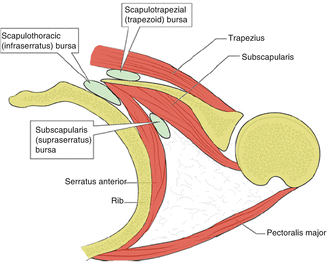Fig. 16.1
Multiple named bursae around the shoulder, AP view (Hubbard and Poehling [6], p 551, with permission of Springer science + Business Media)

Fig. 16.2
Multiple named bursae around the shoulder, axial view (Hubbard and Poehling [6], p 551, with permission of Springer science + Business Media)
16.2 Supra-acromial Bursa
The supra-acromial bursa lies on top of the acromion, subcutaneously, and does not communicate with any of the other bursae or the joint.
16.3 Subcoracoid Bursa
The subcoracoid bursa [1, 2] is located between the subscapularis tendon and the coracoid process, extending under the conjoined tendon of the coracobrachialis and the short head of the biceps. It extends posteriorly beneath the coracoid process. It facilitates movement by reducing friction between the subscapularis tendon and the tendons of the short head of the biceps and the coracobrachialis during the arc of rotation of the humeral head. In many instances, there is a connection of the glenohumeral joint cavity with this bursa. In a small percentage of patients, a natural communication exists between the subcoracoid bursa and the subacromial bursa.
16.4 Subscapular Recess
The subcoracoid bursa should not be confused with the subscapular recess. The subscapular recess, unlike the subcoracoid bursa, is not a separate bursa but rather an outpouching of the glenohumeral joint that protrudes between the glenohumeral ligaments and lies between the subscapularis muscle and the anterior surface of the scapula. The subscapular recess may occasionally extend superiorly and anteriorly over the subscapularis muscle into the subcoracoid space, close to the subcoracoid bursa, and may be confused with the subcoracoid bursa. Although the subcoracoid bursa may communicate with the subacromial-bursa in healthy patients, the subscapular recess does not. The subcoracoid bursa should not communicate with the glenohumeral joint under normal circumstances, the subscapular recess should always communicate with the joint.
16.5 Coracoclavicular Bursa
The coracoclavicular bursa or supracoracoidal bursa is a small bursa between the conoid and trapezoid (coracoclavicular) ligaments. Sometimes more small bursae are described in this region.
16.6 Scapulothoracic Bursae
There are six bursae (two major, four minor) reported participating in scapulothoracic articulation. Two of these bursae, including the scapulothoracic (infraserratus) bursa and subscapularis (supraserratus) bursa, are the primary physiologic bursae [3]. The subscapularis bursa, located between the subscapularis and serratus anterior muscles, is on average 5.3 × 5.3 cm when present. The infraserratus bursa is found under the serratus anterior, overlying the posterolateral chest wall, and is on average. The four minor bursae are not consistently found and are often a result of abnormal scapulothoracic articulation. These are typically found along the inferior angle of the spine, at the superomedial border of the scapula, either above or below the serratus anterior, or deep to the trapezius muscle at the medial base of the scapular spine. The bursae of the superomedial border and inferior angle are frequently pathologic and responsible for symptom generation. One superficial bursa has also been described located between the latissimus dorsi and the inferomedial angle of the scapula. A scapulotrapezial (trapezoid) bursa has been described located between the superomedial scapula and the trapezius muscles [4].
Stay updated, free articles. Join our Telegram channel

Full access? Get Clinical Tree








